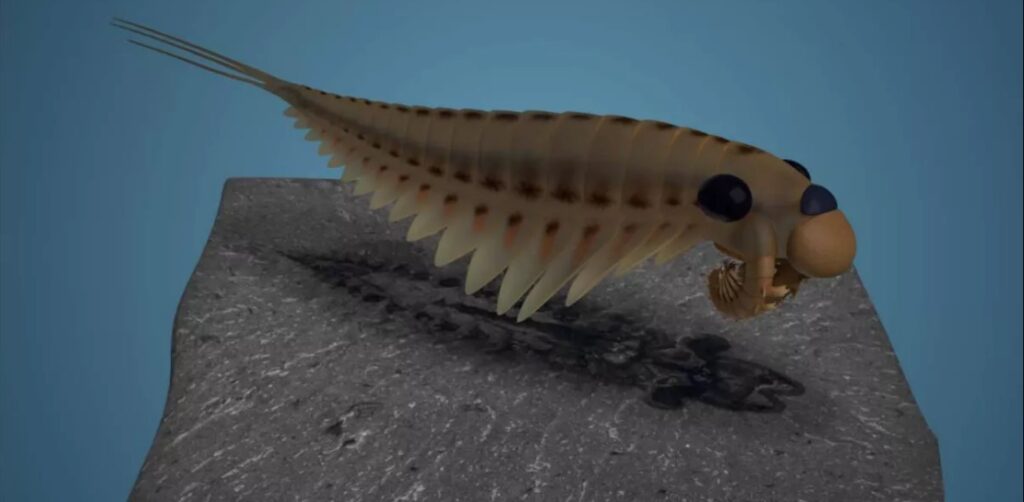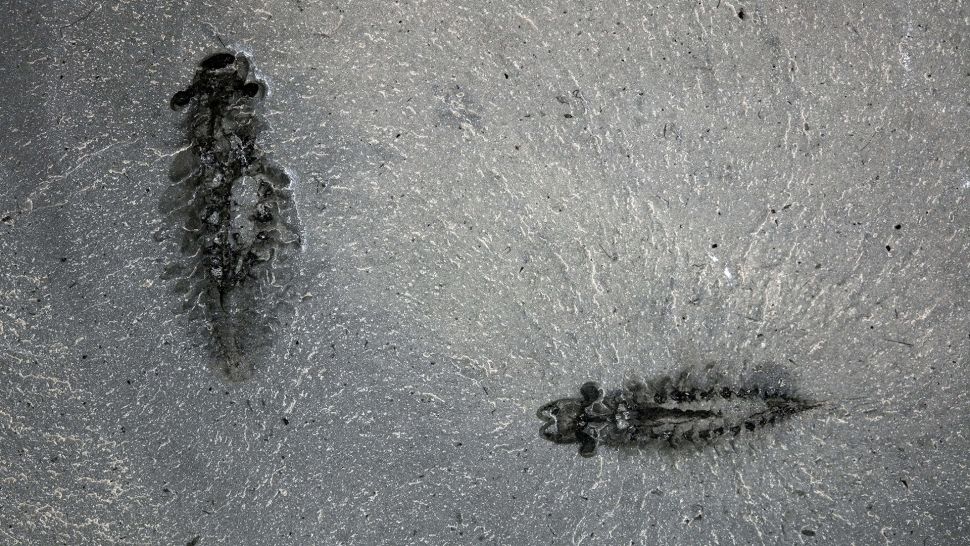@WFS,World Fossil Society, Athira, Riffin T Sajeev,Russel T Sajeev

Royal Ontario Museum/Illustration by Sabrina Cappelli (Image credit: Illustration by Sabrina Cappelli/© Royal Ontario Museum)
What had spiny claws protruding from its mouth, sported a body shaped like a toilet brush and looked as though it slithered off the cover of a sci-fi novel? An ocean predator from the Cambrian period known as Stanleycaris hirpex. Newfound fossils of the bizarre creature are exceptionally complete, preserving the brain, the nervous system and a third eye.
Researchers at the Royal Ontario Museum (ROM) in Toronto recently announced the discovery of fossils belonging to that strange animal as part of an “astonishing” treasure trove of fossils dating to 506 million years ago, according to a statement(opens in new tab).
Paleontologists found these ancient treasures in the Burgess Shale, a formation in British Columbia’s Canadian Rockies that is known for its abundant and well-preserved fossilized animal remains, and among the half-a-billion-year-old fossils were numerous specimens of the marine predator S. hirpex.
“What makes this find so remarkable is that we have dozens of specimens showing the remains of the brain and other elements of the nervous system, and they’re incredibly well preserved and show really fine details,” said Joseph Moysiuk, lead author of a study describing the fossils and a University of Toronto doctoral candidate in ecology and evolutionary biology.
“Before this, there had only been a few other finds of fossilized brains, particularly from the Cambrian period, but this is still something that is quite rare, and it’s only something that’s been observed in the last 10 years or so,” Moysiuk told Live Science. “Most of the species where we’ve seen fossilized brains, there are only one or two specimens available.”
Despite being small — measuring less than 8 inches (20 centimeters) in length — S. hirpex was likely an imposing sight to its even smaller prey.
“It had this really ferocious apparatus of spiny claws and round mouth that made it look absolutely fierce,” Moysiuk said. “It also had long, rake-like spines to comb the seafloor to hunt for any buried organisms, side flaps to help it glide through the water and trident-shaped spines that project toward each other from the opposite appendage that we think it used as a jaw to crush its prey.”

A pair of fossil specimens of Stanleycaris hirpex, specimen ROMIP 65674.1-2. (Image credit: Royal Ontario Museum/Photo by Jean-Bernard Caron)
The fossils show that the brain of S. hirpex was divided into two segments: the protocerebrum, which connected to its eyes, and the deutocerebrum, which linked to the frontal claws. This brain structure differs from the three-lobe structure of modern arthropods that are distant relatives of S. hirpex, such as insects. The brains of these modern relatives, in contrast, comprise a protocerebrum, a deutocerebrum and a tritocerebrum, which connects the brain to an insect’s labrum, or upper lip, among other body parts.
“The preservation of the brains in these animals give us direct insight into the evolution of the nervous system from the perspective of the fossil record,” Moysiuk said.
Radiodonta, an extinct offshoot of the arthropod evolutionary tree that includes Stanleycaris, “is an important group to know, since it offers us a better understanding of the evolution of modern arthropods.” Moysiuk said.
Another interesting aspect of S. hirpex was its oversize median third eye, a characteristic observed for the first time in a radiodont. While the study authors are uncertain about how the ancient arthropod used this eye, it may have helped the animal track its prey, Moysiuk suggested.
“Finding the third eye was quite a shock to us because we were starting to think we understood radiodonts and what they looked like pretty well,” he said. “For the first time, we were able to recognize this gigantic median eye in addition to the pair of stock eyes that we already knew about in radiodonts.”
Though some modern arthropods, like dragonflies and wasps, also have median eyes, they are usually more sensitive than the other two eyes and yet don’t focus as well. “We can only speculate, but we think that this third eye helped with orienting an animal, and it’s especially important for a predator like Stanleycaris that has to move around rapidly and precisely in the environment,” Moysiuk said.
Three of the S. hirpex fossils that were excavated during the dig are now on permanent display at the Royal Ontario Museum in its Willner Madge Gallery, Dawn of Life.
The findings were published July 8 in the journal Current Biology(opens in new tab).
Originally published on Live Science.
@WFS,World Fossil Society, Athira, Riffin T Sajeev,Russel T Sajeev



 September 12th, 2022
September 12th, 2022  Riffin
Riffin  Posted in
Posted in  Tags:
Tags: 